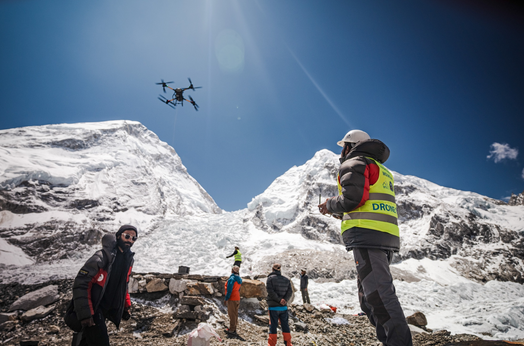
Nepal-based firm Airlift Technology operates a drone from the Everest base camp in May. Source: Airlift Technology
由 Jingyi 翻译,最近效率降低了。
译文
垃圾问题的顶峰
Sheryl Tian Tong Lee
0.人类的垃圾,空的氧气管 ,厨房厨余,废弃的梯子。
1.Sherpas 在珠穆朗玛峰上都捡到了 —— 每个人捡到 20 公斤 —— 徒步了 4 小时,横穿了破碎的冰层,以及错综复杂的裂缝,才把垃圾带到基地。
treacherous 奸诈的
crumbling 崩溃
traverses 穿过
crevass 裂缝
2.在最近的攀岩季节,这个团队拥有了新的来自大僵的无人机助力,这些无人机能够在 6 分钟之内完成上述工作(complete the same journey),还完成了清理现场,由于无人机的巡逻,使得珠峰上不能扔垃圾的区域变大了。
3.无人机的责任,是负责从珠峰基地一拖出垃圾的,基地一距离比起基础营地要高出 6000 多米,距离地面 700 米以下。在大僵 FlyCart 30将绳索和梯子等物资送到山顶之后,Sherpas 将填满垃圾的垃圾袋挂在无人机上,再返回旅程,一直到响彻声音到山脚,听上去就像大的蚊子。
debris-filled garbage bag 填满垃圾的垃圾袋
4.在4月中旬、5月中旬,尼泊尔公司 Airlift 科技公司操作的无人机飞过了超 280 公里的无垃圾区,依据 Sagarmatha 污染控制委员会,一家当地的非盈利的机构,在珠峰管理扔垃圾的问题。
5.无人机是以下工作的一部分,这些工作就是清理珠峰的垃圾,这些工作起到回收站的作用。这个回收站也是全世界最高的垃圾站。工作人员列举了机器人名单,不仅仅能提升过程的速度,还能减少 Sherpas 的危险,因为将几十年来的珠峰的垃圾搬下来还是有危险的。
trash-strewn 回收站
6.“我们很高兴”Lhakpa Sherpas 说到,在徒步团队 Asian Trekking 工作,这些人曾 15 次登顶珠峰。他估计,70% 垃圾是由他们团队搬下来的,今年由无人机来搬运。
7.“如果你从基地1走下来的话,你会觉得暖和,这时候你就会闻到垃圾的味道”还会引起呼吸道问题,Sherpas 说到,“我们需要更多无人机搬运更多吨位的垃圾”。
8.垃圾包括,氧气瓶、绳子、帐篷、罐头、塑料。1993年人们在珠峰发现的。
9.从 1990 年开始,8849 米的珠峰,已经涌入很多垃圾了,珠峰的访问人数越来越多的时候,多次尝试成功登顶珠峰之后。在攀登季节,通常都是四月下旬到五月下旬,数以万人会来到基地这里,尽管每年只有 100 多人试图登顶。
summit attempts 登顶尝试
forfeiting 没收
10.珠峰垃圾问题在较高纬度是最糟糕的,对于保持干净也是很有挑战的,基于成功登顶途中的物流障碍。自从 2019 年以来,尼泊尔军队、Sherpas 团队一起工作,从山上移除 100 多吨垃圾,以及周围几个珠峰。在过去十几年,政府部署了规则,要求攀登的人到基础营地之后,再往上攀登一些,每个人要求带回最起码 8 公斤的垃圾,或者每人没收 4000 美刀,作为登珠峰的代价。
11.气候变化仅仅紧急地清理。冰雪在融化,把积压了十几年的垃圾都展现出来,将水道污染了,本来是有水的(fed by runoff),一直流向山脚下的村庄。与生活垃圾对抗的风险,包括疾病传染、霍乱,去年当地政府已经开启了规定,敦促攀登者保持着丰富的背包,带回基础营地。
12.同时,上升的温度使得垃圾收集更加危险。冰层更脆弱、裂缝更宽了,融化在 Khumbu Glacier 里 —— Khumbu Glacier 坐落在两个营地之间。这引起了冰层坍塌更加快速。
13.更加低的海拔,Khumbu 冰层在冰山山顶,“目前为止最危险的部分,季节结束时候就开始融化”Sherpa 说到。
14.中国无人机,每架 7 万美金,能在零下 20 摄氏度时候飞行,乘着风速有 40 公里每小时。Asian Trekking 称会支付 Airlift 装备费用,还提供垃圾清运服务,如果无人机公司决定官方商用的话。
15.即便如此,是有极限的。无人机不能达到更高的营地,空气更加稀薄。天气在高纬度的地方会很奇怪,在 4 月的航班中,无人机自动部署降落伞,风速达到 60 公里每小时的时候。这时候机器会被拖累、毁坏。
16.意外事件强调了特殊保险的需要,在扩大项目之前,依据 Sherpas,SPCC CEO。这样的政策目前并不起作用,他说,如果没有保险,风险是很大的。
17.Airlift 与尼泊尔官方合作,计划着更多无人机在珠峰上部署,以及在另一个 8000 米高峰上部署。联合创始人 Milan 说到。
18.至少有 5 家无人机厂,无论是美国还是欧洲,已然和 Airlift 开展合作,提供其设备测试。Pandey 说到,在这个高度,我们是唯一干这类业务的。
原文
The Everest of trash problems
By Sheryl Tian Tong Lee
0.Human waste, empty oxygen cylinders, kitchen leftovers and discarded ladders.
1.Sherpas working on Mount Everest carry all that and more — 20 kilograms (44 pounds) per person — navigating a four-hour hike that traverses crumbling glacial ice and treacherous crevasses to bring trash back to base camp.
2.During the most recent climbing season, they had new assistance from two giant SZ DJI Technology Co. drones, which can complete the same journey in six minutes, sharing the task of clearing an expanding volume of refuse piling up on the world’s highest peak.
3.Drones have been deployed to haul garbage from Everest’s Camp 1, which sits at 6,065 meters (19,898 feet) above sea level down to base camp, about 700 meters below. After a DJI FlyCart 30 delivers supplies like ropes and ladders up the peak, Sherpas hook on a debris-filled garbage bag for the drone’s return journey as it buzzes down the mountain, sounding like an oversized mosquito.
4.Between mid-April and mid-May, the drones operated by Nepal-based firm Airlift Technology handled more than 280 kilograms of refuse, according to the Sagarmatha Pollution Control Committee, a local non-profit that manages trash collection on Everest.
5.The drones are part of a growing effort to clean the slopes of the mountain, which has become so trash-strewn, it’s been referred to as the “world’s highest garbage dump.” Enlisting robots can help not only speed up the process but also reduce the danger for the Sherpas carrying decades-worth of garbage down the treacherous peak.
6.“We’re very happy,” said Lhakpa Nuru Sherpa, a 33-year-old Sherpa at local expeditions firm Asian Trekking who has reached the summit of Everest 15 times. He estimates that about 70% of the garbage usually carted off the mountain by his team was transported by drone this year.
7.“When you’re coming down from Camp 1 and it’s warm, you can smell the garbage,” and that has caused respiratory problems for some Sherpas, he said. “We want more drones carrying heavier weights.”
8.Garbage, oxygen cylinders, ropes, tents, cans and plastics on Mount Everest in March 1993. Photographer: Pierre Bessard/AFP/Getty Images
9.The 8,849-meter Everest has seen an influx of trash since the 1990s, when visiting grew in popularity following multiple successful summit attempts. During climbing season, which typically lasts from late April until the end of May, tens of thousands of people trek to base camp, though only hundreds attempt to reach the top of the peak each year.
10.Everest’s garbage problem is worst at higher altitude campsites, which are also more challenging to clean given the logistical hurdles of reaching them. Since 2019, the Nepalese army and Sherpas have worked together to remove more than 100 tons of waste from the mountain and several surrounding peaks. In the last decade, the government has also implemented rules requiring climbers who venture above base camp to carry back at least 8 kilograms of trash each or risk forfeiting a $4,000 deposit that those visiting the mountain must pay.
11.Climate change is only adding to the urgency to clean Everest. Snow and ice are melting, exposing decades-old garbage that can contaminate waterways fed by the runoff and that flow down to villages below. To combat the risks of human waste spreading diseases such as cholera, local officials last year put in place regulations compelling climbers to keep it in doggy bags to be brought back to base camp.
12.At the same time, rising temperatures are making trash collection more dangerous. Ice is weakening, crevasses are widening and meltwater within the Khumbu Glacier — situated between base camp and Camp 1 — is causing ice blocks to collapse more quickly.
13.At lower altitudes, the Khumbu Icefall at the head of the glacier “is by far the most dangerous part of the mountain, and towards the end of the season, it starts to melt,” said Tenzing David Sherpa, a director at Asian Trekking, which employs about 30 Sherpas. “It is much safer for drones to bring down the waste.”
14.The Chinese drones, which cost $70,000 each, can fly in temperatures of minus-20C and brave wind speeds of more than 40 kmh. Asian Trekking said it would pay for Airlift’s equipment and trash delivery services if the drone company decides to officially offer them commercially.
15.Even so, there are limitations. Drones aren’t able to reach higher campsites, where the air is too thin to fly. Weather at high altitude can also be erratic, and during a flight in April, a drone automatically deployed a parachute when wind speeds hit more than 60 kmh. The machine was then dragged and damaged by further gusts.
16.The accident highlighted the need for specialized insurance before expanding the project, according to Tshering Sherpa, SPCC’s chief executive officer. Such policies are not currently readily available and “if we don’t have any insurance, it is a very high-risk project,” he said.
17.Airlift, which is working with Nepalese authorities, is planning to try more drone models on Everest and the country’s other 8,000-meter peaks, said co-founder Milan Pandey.
18.At least five drone manufacturers from the US and Europe have already reached out to Airlift offering their equipment for testing, Pandey said. At these altitudes, “we’re the only company in the world doing this operation.”
原文链接
长按/扫码,有您的支持,我们会更加努力!


|
